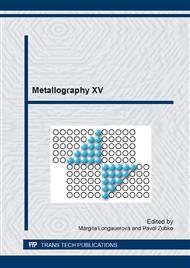p.166
p.172
p.179
p.186
p.191
p.197
p.201
p.205
p.209
Changes of Mechanical Properties in Response to Changes in the Microstructure of High Pressure Steel Cylinders Obtained by the Various Heat Treatments
Abstract:
The field of high-pressure steel cylinders (HPSC) and vessels used for the variety of applications especially for the CNG (Compressed Natural Gas) in automotive industry is still expanding. With increasing safety requirements, a need of new techniques applied in field of HPSC structural innovations comes into place. Conventional treatment provides generally sufficient parameters of HPSC, but the long-term goal is to achieve as high as possible strength properties vs. as high as possible notch impact strength, which is currently difficult fully accessible, because of the banded structures (segregation banding) created during the process of reversed extrusion and reversed hot rolling.
Info:
Periodical:
Pages:
191-196
Citation:
Online since:
April 2014
Authors:
Keywords:
Price:
Сopyright:
© 2014 Trans Tech Publications Ltd. All Rights Reserved
Share:
Citation:


